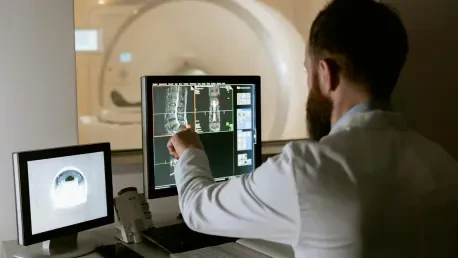In the high-stakes world of emergency medicine, where every minute can mean the difference between recovery and lasting harm, bone fractures stand out as one of the most frequent and urgent conditions requiring immediate attention. Millions of patients arrive at emergency departments each year with injuries stemming from car crashes, falls, or violent encounters, placing immense pressure on medical staff to deliver swift and accurate diagnoses. Traditional X-ray imaging, valued for its accessibility and low cost, serves as the primary tool for identifying fractures, yet it demands specialized expertise for interpretation—a resource often in short supply, especially during late-night shifts or in understaffed facilities. This persistent gap in timely expert analysis creates a critical need for innovative solutions that can enhance diagnostic speed without compromising reliability.
Artificial intelligence (AI) emerges as a potential game-changer in this challenging landscape, offering the promise of rapid, consistent analysis of X-ray images to detect fractures with precision. By leveraging vast datasets of medical imaging, AI tools can act as a virtual assistant to radiologists and emergency physicians, potentially easing the burden in chaotic hospital environments. A specific AI system, SmartUrgence® by Milvue, has recently undergone evaluation in a real-world emergency setting, demonstrating capabilities that could redefine how fractures are diagnosed under pressure. However, while the technology shows significant potential, lingering questions about its accuracy compared to established methods, its adaptability to varied injuries, and its seamless integration into clinical workflows remain unanswered.
The exploration of AI’s role in emergency diagnostics reveals a complex interplay of innovation and limitation. As hospitals grapple with rising patient volumes and constrained resources, the allure of a tool that could streamline fracture detection is undeniable. Yet, the path to widespread adoption is fraught with challenges, from technical shortcomings to practical implementation hurdles. Delving into these aspects provides a clearer picture of whether AI can truly transform emergency care or if it remains a promising but incomplete solution in the face of critical medical demands.
Addressing the Crisis in Emergency Fracture Detection
Pressures of High-Volume Trauma Care
The relentless pace of emergency departments worldwide often centers on the diagnosis and management of bone fractures, which constitute a major portion of trauma cases. Originating from diverse causes such as traffic accidents, workplace mishaps, or simple falls, these injuries demand immediate attention to prevent complications like chronic pain or improper bone healing. In regions with high trauma incidence, such as parts of Egypt, the influx of fracture patients can strain even the most robust medical systems, particularly when resources are limited. X-rays, while efficient and widely available, rely heavily on skilled interpretation, a bottleneck that becomes glaringly evident in high-pressure scenarios where every decision must be made swiftly.
Compounding this challenge is the variability in access to radiologic expertise, especially during off-hours or in rural hospitals where specialists may not be on-site. Junior clinicians or general practitioners often find themselves tasked with deciphering complex X-ray images under tight time constraints, increasing the risk of diagnostic errors. Missed or delayed fracture identification can lead to severe patient outcomes, from prolonged suffering to irreversible damage. This environment of urgency and scarcity underscores the desperate need for supportive technologies that can bolster diagnostic capabilities, ensuring that critical injuries are neither overlooked nor misjudged amidst the chaos of emergency care.
AI as a Potential Lifeline for Overburdened Systems
Artificial intelligence presents a compelling solution to the diagnostic dilemmas faced in emergency settings by offering rapid, data-driven analysis of X-ray images. Unlike human interpreters who may falter under fatigue or distraction, AI systems maintain consistent performance, processing thousands of images with speed that could prove invaluable during peak hospital hours. Tools like SmartUrgence® are designed to flag potential fractures, reducing the mental workload on medical staff and allowing them to prioritize patient treatment over prolonged image analysis. This technology holds particular promise for underserved areas, where access to expert radiologists is often limited or nonexistent.
Beyond mere speed, AI’s capacity to learn from extensive datasets enables it to detect subtle fracture patterns that might escape notice in a high-stress environment. By acting as a reliable second opinion, such systems could enhance the confidence of less experienced clinicians, ensuring more accurate initial assessments. If integrated thoughtfully into existing protocols, AI has the potential to not only improve patient outcomes but also reshape operational efficiency in emergency departments. The prospect of reducing diagnostic errors through automated support could mark a significant step forward, addressing long-standing gaps in trauma care delivery.
Evaluating AI’s Diagnostic Capabilities with SmartUrgence®
Strong Performance Under Real-World Conditions
SmartUrgence®, a CE-certified AI tool developed by Milvue, has demonstrated noteworthy effectiveness in identifying bone fractures through X-ray imaging within a demanding emergency context at a high-volume hospital in Egypt. In a comprehensive study involving 300 adult patients, the tool achieved a sensitivity of 91.13%, accurately detecting over 91% of actual fracture cases, alongside a specificity of 95.45%, which reflects a minimal rate of false positives. With an overall accuracy of 93.67% and an area under the ROC curve of 0.933, SmartUrgence® exhibits robust discriminatory ability, ensuring that both missed diagnoses and unnecessary treatments are kept to a minimum in critical care scenarios.
These performance metrics position the AI system as a valuable asset, particularly for peripheral limb fractures, which were prevalent among the study’s participants. The positive predictive value of 93.39% and negative predictive value of 93.85% further affirm its reliability in confirming or excluding fractures, aligning with broader trends in radiology-focused AI research. Such results suggest that SmartUrgence® could significantly support emergency medical teams by providing quick, dependable assessments, thereby alleviating some of the intense pressure faced during peak trauma hours. The ability to maintain high accuracy in a real-world setting hints at the transformative potential for AI in streamlining fracture diagnosis.
Benchmarking Against Advanced Imaging Standards
Despite the impressive statistics, SmartUrgence® does not reach the diagnostic precision of computed tomography (CT) scans, widely regarded as the gold standard for fracture detection due to their detailed imaging capabilities. The study revealed a statistically significant difference (P
In practical application, this limitation suggests a complementary role for AI within clinical workflows, where it could serve as an initial screening mechanism to identify clear-cut fractures, reserving CT scans for more ambiguous or severe cases. Such a tiered approach could optimize resource allocation in busy emergency departments, ensuring that advanced imaging is used judiciously while still addressing urgent needs. However, the gap in performance with CT scans serves as a cautionary note—over-reliance on AI without backup from established methods could risk overlooking critical injuries, necessitating a balanced integration to maintain patient safety.
Navigating Ambiguity with a Cautious Approach
A distinctive strength of SmartUrgence® lies in its prudent handling of diagnostic uncertainty, with the tool flagging 5.7% of cases as “doubtful” for further evaluation. These ambiguous cases, often resulting from suboptimal image quality or subtle fracture characteristics, were subsequently verified through CT scans, revealing that 65% were non-fractures and 35% were confirmed fractures. This built-in mechanism to avoid definitive misclassification in uncertain scenarios underscores AI’s potential to minimize errors by prompting additional scrutiny rather than forcing a potentially incorrect conclusion under pressure.
This cautious design reinforces the value of human-AI collaboration in emergency diagnostics, where technology acts as a preliminary filter rather than the final arbiter. By highlighting cases that require deeper investigation, the tool ensures that complex injuries are not missed due to rushed assessments, preserving the critical role of clinical judgment. Such an approach is particularly relevant in the unpredictable nature of trauma care, where variability in patient presentation and imaging conditions can complicate diagnosis. The emphasis on partnership between AI and medical professionals points to a future where technology enhances, rather than overrides, human expertise in high-stakes environments.
Hurdles in AI Adoption for Fracture Diagnosis
Constraints in Anatomical Coverage
While SmartUrgence® performs admirably in detecting peripheral fractures affecting limbs—such as those in hands, wrists, ankles, and feet—its current certification does not extend to axial skeletal injuries involving the spine or skull. This restriction significantly limits its applicability in cases of severe trauma, where central fractures often pose life-threatening risks and require comprehensive evaluation. The study noted an even split of fractures between upper and lower limbs, with ankle and wrist injuries being common, yet the exclusion of axial regions means the tool cannot address a critical subset of emergency cases.
This anatomical variability signals a pressing need for expanded AI training to encompass a wider range of fracture types and locations. Complex structures and overlapping anatomies in areas like the spine present unique diagnostic challenges that existing datasets may not adequately cover. Until AI systems can reliably assess injuries across the entire skeletal framework, their utility in emergency care will remain partial, necessitating reliance on conventional imaging for certain trauma scenarios. Addressing this gap is essential for AI to evolve into a more holistic diagnostic aid, capable of supporting clinicians in all facets of fracture management.
Barriers in Transparency and Workflow Integration
Another notable challenge with SmartUrgence® is its “black-box” operation, delivering binary results without explaining the rationale behind fracture detection or providing details on injury severity. This lack of transparency can hinder its practical use, particularly for clinicians with limited radiology experience who may find it difficult to interpret or trust the AI’s outputs without context. In the fast-moving environment of an emergency department, such opacity could slow down decision-making processes or create uncertainty, potentially undermining the tool’s intended benefits.
Additionally, integrating AI into existing clinical workflows poses logistical difficulties that extend beyond the technology itself. Variables such as inconsistent image quality, the need for staff training to understand AI results, and compatibility with hospital systems can affect performance and adoption. The study’s focus on a single institution also raises concerns about whether these findings would hold across diverse healthcare settings with varying patient demographics and operational protocols. These practical obstacles indicate that while AI offers significant promise, its transition from experimental tool to standard practice requires meticulous planning and adaptation to real-world conditions.
Charting the Path Forward for AI in Emergency Care
Advancing AI for Broader Diagnostic Reach
To truly transform fracture diagnosis in emergency settings, AI tools like SmartUrgence® must progress beyond their current capabilities to address complex cases, including axial fractures and subtle injuries that remain difficult to detect. Expanding training datasets to incorporate a diverse array of anatomies and less common fracture patterns is a crucial step toward achieving this goal, ensuring the technology can handle a wider spectrum of trauma scenarios. Furthermore, enhancing AI systems to assess fracture severity or specific characteristics—moving past simple binary outputs—would provide clinicians with more actionable information for tailoring treatment strategies.
Such improvements would position AI as a more versatile diagnostic partner, capable of supporting medical professionals in a broader range of emergency situations. Collaboration between technology developers and healthcare providers will be vital to refine these systems, aligning them with the nuanced demands of clinical practice rather than limiting them to straightforward cases. By focusing on comprehensive coverage and detailed outputs, AI could evolve into an indispensable tool, significantly enhancing the ability to manage diverse fracture presentations under time-sensitive conditions.
Ensuring Robust Validation and Seamless Adoption
Future efforts should emphasize multi-center studies to evaluate AI tools across varied healthcare environments, confirming their efficacy in different populations and hospital setups. The current research on SmartUrgence®, conducted within a single Egyptian hospital, leaves uncertainty about its performance in other contexts, where patient profiles and operational challenges may differ. Larger, more inclusive trials would help identify potential biases or practical issues, providing a foundation for standardized protocols on AI application in emergency diagnostics.
Equally important is the focus on integrating AI smoothly into clinical routines, which involves training medical personnel to interpret and trust AI-generated insights confidently. Establishing clear guidelines for managing uncertain cases flagged by AI, as well as ensuring compatibility with existing hospital technologies, will be critical to successful implementation. Overcoming these logistical barriers could determine whether AI transitions from a promising innovation to a fundamental component of emergency care, ultimately improving diagnostic accuracy and patient outcomes on a global scale.









